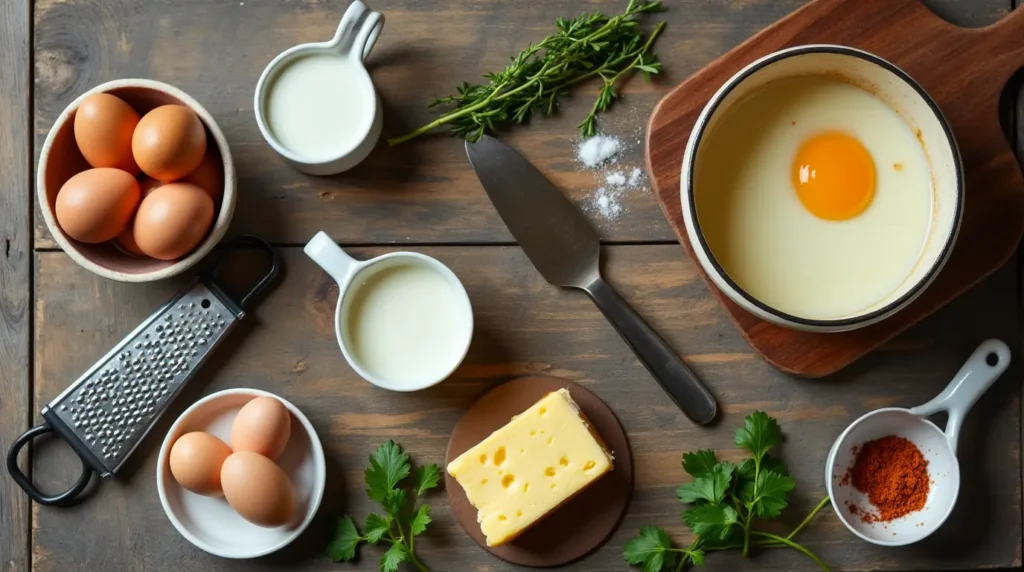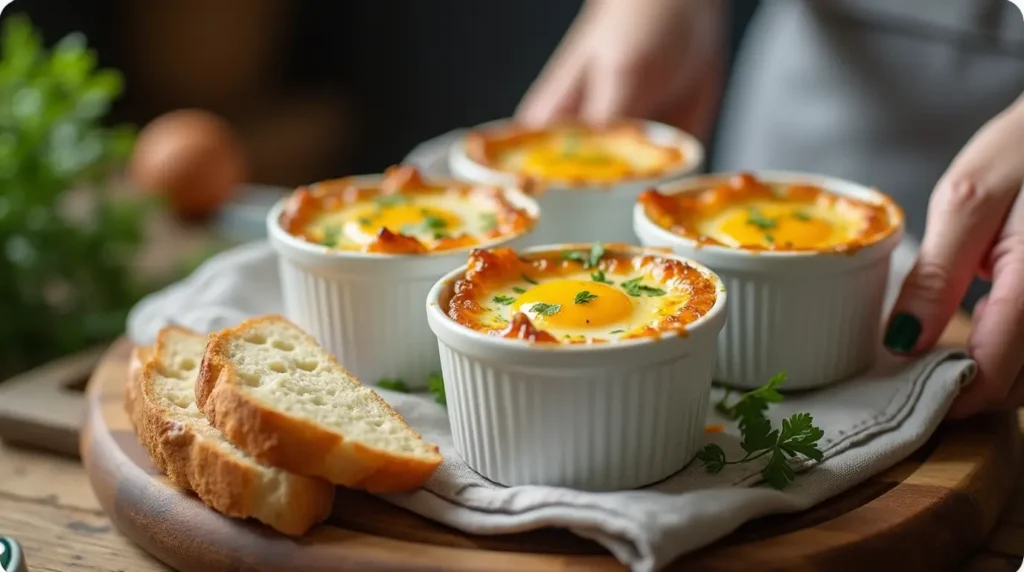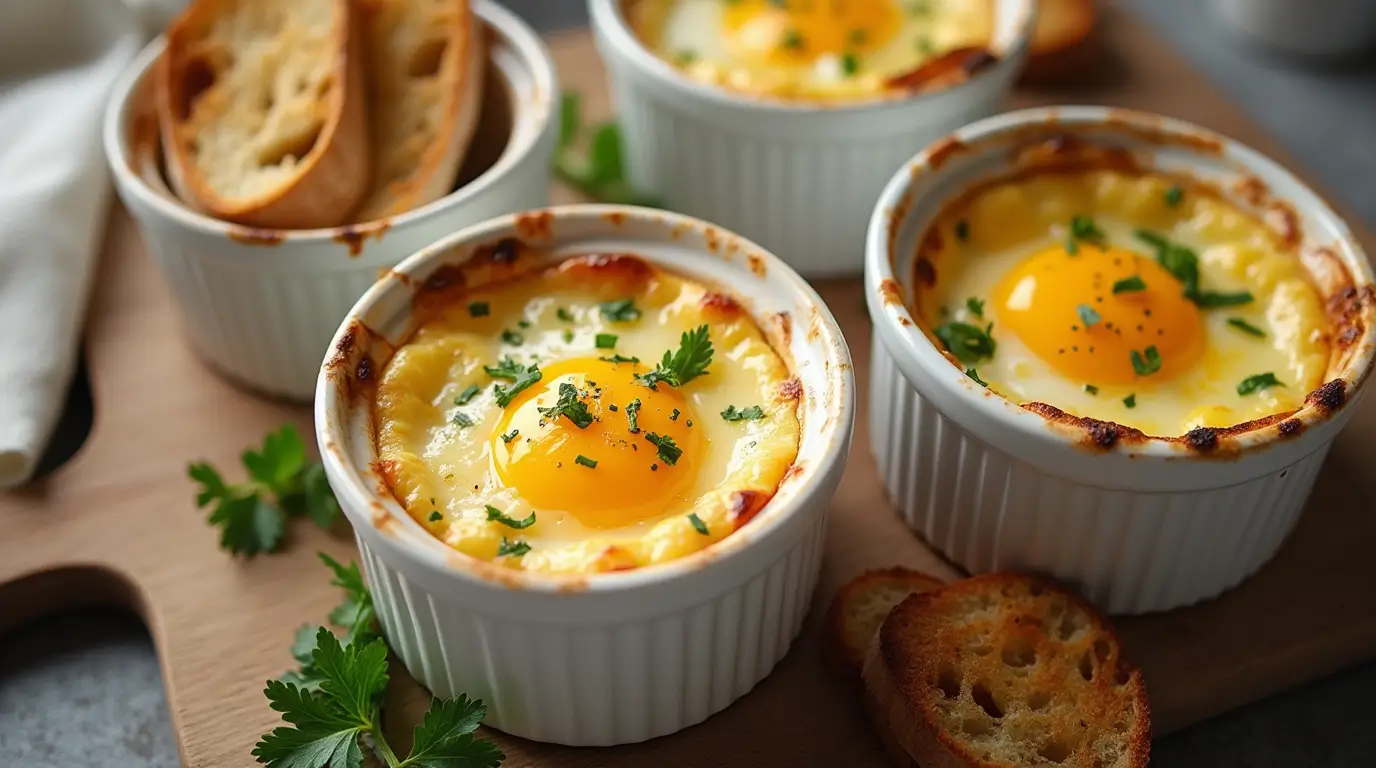Eggs en Cocotte, also known as baked eggs, deliver a creamy, rich, and satisfying dish that’s as simple as it is elegant. With minimal prep and a luxurious presentation, this recipe is perfect for breakfast, brunch, or even a cozy dinner. Wholesome, flavorful, and endlessly versatile, it’s a timeless recipe to suit any occasion.
Introduction
Few dishes balance simplicity and elegance as perfectly as Eggs en Cocotte. This French-inspired classic brings together creamy textures and rich flavors in a dish that’s as comforting as it is impressive. Whether you’re hosting a weekend brunch or seeking a quick but indulgent meal, Eggs en Cocotte offers a solution that feels both upscale and effortless.
The name itself—Cocotte—means “small pot” in French, referring to the ramekins traditionally used for baking these delectable eggs. The customizable nature of the recipe allows you to tailor the dish to your preferences, whether by adding vegetables, cheese, or even a touch of cream. It’s a delightful way to elevate the humble egg into something extraordinary, suitable for any time of day.
Table of Contents
Key Takeaways
- Taste & Presentation: Eggs en Cocotte are creamy, savory, and visually stunning with their golden yolk peeking out of a silky white base.
- Dietary Notes: This dish is naturally gluten-free and vegetarian, making it accessible for many dietary needs.
- Ease of Preparation: With a short list of ingredients and simple techniques, even novice cooks can master this recipe with ease.
Recipe Card
| Prep Time | Cook Time | Total Time | Servings | Calories per Serving |
|---|---|---|---|---|
| 10 minutes | 15 minutes | 25 minutes | 4 | 180 |
Ingrédients
| Ingredient | Quantity | Notes |
|---|---|---|
| Eggs | 4 | Large and fresh |
| Heavy cream | 1 cup | For creaminess |
| Butter | 1 tbsp | For greasing ramekins |
| Gruyère cheese | 1/2 cup | Shredded, optional |
| Fresh herbs (e.g., parsley, thyme) | 1 tbsp | Finely chopped |
| Salt | To taste | Adjust per preference |
| Black pepper | To taste | Freshly ground preferred |

Step-by-Step Recipe Instructions for Eggs En Cocotte
Step 1: Prepare the Ramekins
Instructions:
Start by preheating your oven to 375°F (190°C). Generously grease the inside of each ramekin with butter to ensure the eggs don’t stick and for added richness. Place the ramekins into a baking dish with high sides to prepare for a water bath.
Tip: For added flavor, rub a clove of garlic inside each ramekin before greasing it with butter.
Step 2: Assemble the Ingredients
Instructions:
Pour a tablespoon of heavy cream into the bottom of each ramekin. Crack one egg gently over the cream, ensuring the yolk remains intact. Sprinkle with salt, pepper, and a pinch of fresh herbs. If desired, top with shredded Gruyère cheese for a gooey, savory touch.
Tip: Let the eggs come to room temperature before cracking them—they’ll bake more evenly.
Step 3: Create the Water Bath
Instructions:
Boil water in a kettle and carefully pour it into the baking dish, surrounding the ramekins halfway up their sides. This water bath (or bain-marie) ensures gentle, even cooking, resulting in silky-smooth eggs.
Tip: Use hot water, not boiling, to prevent sudden temperature changes that could crack the ramekins.
Step 4: Bake the Eggs
Instructions:
Gently place the baking dish into the preheated oven. Bake the eggs for 12–15 minutes, or until the egg whites are set but the yolks remain soft and runny.
Tip: Keep a close eye on the eggs during the final few minutes of baking, as overcooking can produce a firmer yolk.
Step 5: Serve and Enjoy
Instructions:
Use tongs or an oven mitt to carefully remove the ramekins from the water bath. Let them cool slightly before serving. Garnish with additional fresh herbs, a sprinkle of sea salt, and a drizzle of olive oil if desired. Serve with crusty bread or a light side salad for a complete meal.
Tip: Serve the eggs directly in their ramekins for an elegant presentation.
Notes
- Substitutions: Swap heavy cream with coconut milk for a dairy-free version or use Parmesan cheese instead of Gruyère for a sharper flavor.
- Customizations: Add sautéed spinach, smoked salmon, or mushrooms to the ramekins before adding the eggs for extra texture and flavor.
- Serving Suggestions: Pair with freshly baked baguette slices or a side of roasted asparagus for a well-rounded plate.
Nutrition Information
| Nutrient | Amount per Serving |
|---|---|
| Calories | 180 |
| Total Fat | 15g |
| Saturated Fat | 8g |
| Cholesterol | 195mg |
| Sodium | 150mg |
| Total Carbohydrates | 1g |
| Dietary Fiber | 0g |
| Sugars | 0g |
| Protein | 7g |
Tools and Equipment Needed
| Equipment | Purpose |
|---|---|
| Ramekins | To hold and bake individual portions |
| Baking dish | For the water bath |
| Whisk | To mix cream or other optional ingredients |
| Kettle | To heat water for the water bath |
| Oven mitts or tongs | To safely remove ramekins from the hot dish |
The History of Eggs en Cocotte
Eggs en Cocotte traces its origins to the heart of French cuisine, where simplicity and elegance have always been celebrated. The term “cocotte” originally referred to small, oven-safe pots used for individual servings, embodying the French ethos of transforming humble ingredients into extraordinary dishes. This recipe became a breakfast and brunch staple in 19th-century France, favored for its rich yet light flavors and its adaptability to seasonal ingredients. Over time, it earned its place as a cornerstone of French home cooking, often featured in culinary schools as a beginner-friendly yet refined dish.
As the recipe spread across borders, it evolved to reflect regional preferences and cultural twists. In some interpretations, chefs began incorporating locally sourced herbs, cheeses, or meats to make it their own. Today, Eggs en Cocotte continues to be a symbol of versatility, offering endless opportunities for customization while staying true to its roots. Its appeal lies in its ability to balance sophistication with ease, making it a favorite across cultures and generations.

Common Mistakes to Avoid
One of the most common mistakes when preparing Eggs en Cocotte is overcooking the eggs, which can result in rubbery whites and a hardened yolk. This is often caused by leaving the dish in the oven for too long or using too high a temperature. Always keep an eye on the eggs during the final minutes of baking to ensure they remain creamy and slightly runny.
Another pitfall is neglecting the water bath, which is essential for even cooking. Skipping this step or using insufficient water can lead to uneven textures. Finally, improper seasoning—whether too much salt or not enough—can throw off the delicate balance of flavors. Be mindful of salt levels, especially if you’re incorporating salty ingredients like cheese.
Why You’ll Love This Recipe
- Flavor Profile: Eggs en Cocotte is rich, creamy, and indulgent, with a buttery aroma and hints of fresh herbs that elevate its simple ingredients.
- Ease of Preparation: With minimal steps and accessible ingredients, this recipe is perfect for both beginner cooks and seasoned chefs.
- Versatility: Whether you’re hosting a brunch, preparing a solo breakfast, or serving a light dinner, this dish fits every occasion and can be customized endlessly.
Key Ingredients and Substitutions
Eggs are, of course, the star of this recipe, and their freshness is crucial for achieving the best results. Heavy cream adds a luscious texture, but it can be replaced with half-and-half for a lighter option or coconut milk for a dairy-free alternative. Gruyère cheese is traditionally used for its nutty, melty qualities, but cheddar or Parmesan also work well.
Fresh herbs, such as parsley, thyme, or chives, lend a bright and fragrant touch to the dish. If fresh herbs are unavailable, dried herbs can be substituted, though their flavor will be more concentrated, so use sparingly. Butter is used to grease the ramekins and enhance flavor, but olive oil can be a good option for those avoiding dairy.
Culinary Magic: The Pleasure of Making This Recipe
The beauty of Eggs en Cocotte lies in its simplicity. Each step, from cracking the eggs to creating the water bath, feels like a culinary ritual, connecting you to generations of cooks who’ve prepared this dish before. Watching the eggs bake into creamy perfection and savoring the first spoonful is a joy that’s as satisfying as the dish itself.
Troubleshooting Common Issues
[Problem]: The eggs are overcooked and rubbery.
[Solution]: Reduce the baking time and closely monitor during the last few minutes. The whites should just sit while the yolks remain runny.
[Problem]: The ramekins cracked during baking.
[Solution]: Ensure the water bath is filled with hot, but not boiling, water to avoid sudden temperature changes.
[Problem]: The egg whites are undercooked.
[Solution]: Cover the ramekins loosely with foil during baking to ensure even cooking without overcooking the yolks.
Expert Tips for Success
- Use room-temperature eggs for more even cooking.
- For an extra creamy texture, whisk the heavy cream with a pinch of nutmeg before adding it to the ramekins.
- When adding cheese, choose varieties that melt well and complement the eggs, such as Gruyère, Fontina, or aged cheddar.
- Invest in high-quality ramekins to ensure even heat distribution and avoid cracking.
Variations and Customizations
For a vegetarian twist, add sautéed mushrooms, spinach, or caramelized onions to the ramekins before adding the eggs. If you prefer a smoky flavor, incorporate cooked bacon or smoked salmon. For those seeking spice, a pinch of paprika or a dash of hot sauce can take this dish to another level.
Vegan adaptations are also possible by substituting the eggs with a tofu-based scramble or chickpea flour mixture and using coconut cream instead of heavy cream.
Storing Leftovers (Refrigeration/Freezing)
To store leftovers, cover the cooled ramekins with plastic wrap or foil and refrigerate for up to 2 days. For freezing, transfer the contents to an airtight container and freeze for up to 1 month.
Reheating Tips: To maintain the best texture, reheat the dish in a preheated oven at 325°F (160°C) until warmed through. Avoid microwaving, as it can overcook the eggs and alter the creamy consistency.
Serving Suggestions
Eggs en Cocotte pairs beautifully with toasted baguette slices or buttered croissants for dipping. For a heartier meal, serve alongside a fresh green salad or roasted vegetables. Complement the dish with a light white wine or a mimosa for brunch, or a freshly brewed cup of coffee for breakfast.
Frequently Asked Questions
Can I make Eggs en Cocotte without heavy cream?
Absolutely! While heavy cream adds richness to the dish, you can substitute it with half-and-half, whole milk, or even a plant-based alternative like coconut cream or almond milk for a dairy-free version. Keep in mind that lighter substitutes may result in a less creamy texture.
What can I use if I don’t have ramekins?
If you don’t have ramekins, you can use small oven-safe bowls, mugs, or even a muffin tin. Just be sure to adjust the baking time accordingly, as larger or thinner containers may cook faster.
How do I avoid overcooking the eggs?
To prevent overcooking, bake the Eggs en Cocotte in a water bath (bain-marie) and monitor them closely during the last few minutes. The whites should be just set, and the yolks should remain soft and slightly runny. If needed, remove them from the oven a little early and let residual heat finish cooking.
Can I add extra ingredients to the ramekins?
Yes! Eggs en Cocotte is incredibly versatile. You can add sautéed vegetables like spinach, mushrooms, or tomatoes; cooked meats like bacon or ham; or even smoked salmon for a more indulgent twist. Layer these ingredients at the bottom of the ramekin before adding the eggs and cream.
What’s the best way to reheat leftover Eggs en Cocotte?
Reheat leftover Eggs en Cocotte by placing the ramekins in a preheated oven at 325°F (160°C) for a few minutes until warmed through. Avoid using the microwave, as it may overcook the eggs and alter their creamy texture. For best results, consume the dish fresh on the day it’s made.
Related Recipes
If you enjoyed Eggs en Cocotte, you might love exploring other comforting and versatile egg-based dishes. Consider trying Shakshuka, a Middle Eastern favorite featuring poached eggs in a spicy tomato sauce, or the classic Quiche Lorraine, a French tart filled with eggs, cream, and bacon. For a lighter option, experiment with Egg Muffins, perfect for a quick and healthy breakfast on the go. If you’re craving something hearty, Huevos Rancheros combines eggs with tortillas, beans, and salsa for a flavorful Tex-Mex twist. These recipes share the same simplicity and adaptability that make Eggs en Cocotte so beloved.
Conclusion: A Delicious Intersection of Tradition and Modernity
Eggs en Cocotte stands as a testament to the timeless appeal of simple yet refined cooking. Rooted in French culinary tradition, this dish encapsulates elegance, versatility, and the ability to transform everyday ingredients into something extraordinary. Its creamy texture, rich flavor, and visually stunning presentation make it a go-to recipe for any occasion, whether you’re savoring a quiet breakfast or impressing guests at brunch.
This recipe also demonstrates how classic dishes can adapt to modern tastes and dietary preferences, ensuring their place on our tables for generations to come. By customizing ingredients, experimenting with flavors, and embracing the ease of preparation, you make this dish your own. So why not give it a try? Share the joy of Eggs en Cocotte with friends and family, and let the tradition continue.
Call to Action
Ready to make this delicious Eggs en Cocotte recipe? It’s time to roll up your sleeves and bring this French classic to life in your kitchen. Whether you’re cooking for a crowd or treating yourself, this recipe promises to impress with its simplicity and sophistication.
We’d love to hear how your Eggs en Cocotte turns out! Did you try any customizations or add your special twist? Let us know your tips, tricks, and favorite pairings in the comments below. Share your success stories (or troubleshooting moments!) and join the conversation with fellow food lovers. Happy cooking!

